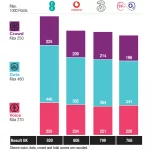Report Slams Inadequate Rural Mobile Signals and Broadband Lines
New research from Rural England CIC, which found that mobile calls cannot be made inside 33% of rural buildings on any network (vs 3% in urban premises), has warned that people living in UK rural areas are being “cut off from building businesses” and accessing digital services due to “inadequate” connectivity.
The report (‘State of Rural Services’), which will be launched today in Parliament and looks at vital services across key areas (i.e. health, public transport, libraries, young people’s services and retail etc.), also found that a 4G (mobile broadband) connection cannot be accessed in more than half (58%) of rural premises, compared with just 17% in cities.
On top of that the report also uses the latest data from Ofcom (here) to highlight how 11% of rural premises could not get a 10Mbps+ fixed line connection and 24% could not get a 30Mbps (superfast broadband) connection. The equivalent urban figures are 1% and 3% respectively.
Advertisement
Overall it claims that around 17% of England’s population lives in a rural area and nearly a quarter of those are over the age of 65 (they’re particularly vulnerable when underinvestment occurs in healthcare and declining high streets). Not to mention the Government’s plan to digitise GP services and process universal credit applications online, which is all well and good unless the local connectivity is poor.
Per cent of England’s population that is resident in rural areas 17.0%
Rate of population growth in rural England from 2011 to 2016 +2.6%
Advertisement
Per cent of rural population that is aged 65 or over 24.1%
Number of registered businesses in rural England (2016/17) 547,000
People employed by registered businesses in rural England 3,517,000
According to the research, less public funding is directed towards rural residents than in urban areas, despite the higher cost of providing essential services such as social care, education and public transport in rural parts. For example, local authority expenditure on public transport is significantly higher in predominantly urban areas with 63% more spent on bus subsidies, and 348% more on discretionary concessionary fares.
Other Key findings from the Report
» Take up of superfast broadband services is growing. In 2017 some 39% of rural premises that could access such a connection had opted to take it up.
» There is a 36% discrepancy in funding per head that rural local authorities receive for public health duties in comparison with their urban counterparts.
» Young people from rural areas tend to score worse on a number of key public health indicators – risky behaviour, alcohol consumption, smoking and being bullied.
» 89% of rural journeys are made by car (73% for urban residents).
» In 2017 half of farmers only had dial-up fixed line connection speeds (below 2 Mbps).
» Local authority 2017/18 budgets per resident for library services were 25% less in predominantly rural areas than in predominantly urban areas.
» In 2016/2017, 191 bus services were reduced and 202 were withdrawn altogether from shire areas.
» Residents of small rural settlements now travel 4,177 more miles annually on all forms of transport than their urban counterparts (including on foot). They spend on average 384 hours (or 16 days) every year on the go.
» With the number of over-85s expected to double over the next 20 years in rural areas, there are serious concerns about rising demands upon local health services, yet the report finds that almost 30% of rural residents live more than 30 minutes’ drive time from a major hospital, rising to 90 per cent if they are travelling by public transport or walking. Over 40% live more than an hour away by public transport or walking.
» Business satisfaction with connectivity is lowest in remote rural areas and among those whose job requires them to travel. Research on digital potential found rural businesses are concerned about their connection reliability, as well as its speed.
» The main digital benefits identified by rural businesses are remote working, access to customers/suppliers and business efficiency. Benefits are felt most by businesses that have superfast connections.
» More than half of rural businesses face digital constraints other than connectivity. This includes access to digital/IT support, workforce IT skills and recruiting those skills. Addressing such constraints could add significantly to rural productivity.
At this point we’d like to highlight that the above reference to sub-2Mbps speeds being “dial-up” connections is a little confusing. Narrowband dial-up services, which have now largely ceased to exist, tended to offer peak speeds of around 56Kbps (64-128Kbps on ISDN) or 0.056Mbps if you prefer. By comparison the earliest ADSL copper broadband lines started at around 0.5-2Mbps.
Advertisement
Brian Wilson, Report Author, said:
“Nearly a fifth of people in England live in rural areas, yet the evidence shows that many of them face inadequate services, such as being unable to make mobile phone calls or being without transport options. Two years after we released the first State of Rural Services report it seems clear that rural residents frequently still lose out in terms of funding and access to services.
The challenges facing rural communities are likely to grow in the coming years and this will be reflected in their service needs. If policies and service delivery were properly rural proofed it seems evident that those needs would be much better met.”
Similarly Graham Biggs, CEO of the Rural Services Network, has warned that the “country faces a time bomb” if nothing is done to address the needs of rural residents. However the current Government has already committed to extend geographic mobile network coverage to 95% of the UK by 2022. In keeping with that Ofcom’s forthcoming auction of the 700MHz mobile spectrum band will come attached to new obligations.
The 700MHz Coverage Obligation
The binding coverage rules mean that up to two winning bidders would each have to, within 4 years of the award:
1. Extend good, outdoor data coverage to at least 90% of the UK’s entire land area within four years of the award.
2. Improve coverage for at least 140,000 homes and offices which they do not already cover. This means new coverage will be targeted at areas that are harder to reach; and
3. Provide coverage from at least 500 new mobile mast stations in rural areas. This will ensure operators transform coverage in areas where it is lacking, rather than meeting the rules by just boosting existing signals.
Of course the above assumes that mobile operators don’t end up delaying the auction through more disputes and that deployment of related infrastructure is built without the usual problems with planning permission, wayleave agreements and so forth.
Meanwhile the Broadband Delivery UK programme is still hoping to ensure that around 98% of premises can access a fixed “superfast broadband” (24Mbps+) service by the end of 2020. After that the industry funded 10Mbps+ Universal Service Obligation (USO) is expected to help tackle those stuck in the final 2%.
Mark is a professional technology writer, IT consultant and computer engineer from Dorset (England), he also founded ISPreview in 1999 and enjoys analysing the latest telecoms and broadband developments. Find me on X (Twitter), Mastodon, Facebook, BlueSky, Threads.net and Linkedin.
« 6 Years On – UK ISP Supanet Chase Former Customers for Unpaid Bills UPDATE


















































Comments are closed